Lesson 3: The Aircraft and Its Environment
(Approx. time to complete: 20 minutes.)
Here we will focus on the airplane, how it flies, and the environment it operates in. Becoming more familiar with these subjects will answer questions and ease concerns which come up during flight.

The Plane
Commercial airline pilots go to great lengths to make your flight as smooth and motionless as possible, but you should know that these planes can really perform if needed. They have big powerful engines, sturdy efficient wings, and very responsive controls. Technically, these jets are not certified to be aerobatic, but they can really maneuver. We could even do loops and rolls, but I promise we won't!
Please don't be in denial about the plane. It is primarily designed as a flying machine, you should feel very safe on it.

Your Airplane is Not Going to Fall Apart
The FAA mandates that modern jet aircraft are designed and built with large safety margins. All aircraft and their equipment are built from FAA-approved designs and manufactured under FAA-approved systems.
Coming out of the factory the planes are thoroughly flight tested before certification by the FAA. Airliners can withstand many times the stresses and forces which can be imposed upon them in flight.
The wing of an aircraft is very strong. The wing is commonly built as one continuous unit extending through the fuselage. It is constructed with huge reinforced spars.
Unless one were to fly at speeds far greater than normal, there is no way the wing of an aircraft can produce enough lift to bend or break any of its structure. As long as you don't fly unusually fast, even very strong turbulence will not damage an aircraft, the wings just can't produce enough of a lifting force to bend anything.
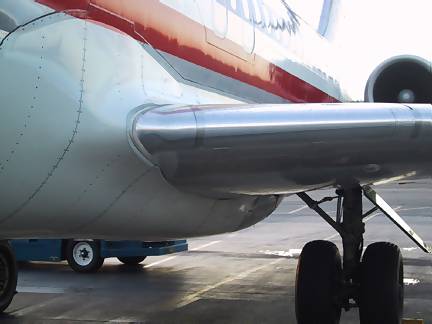
Your Airplane is Not Going to Lose Control
Airplanes have a built-in stability, they will not tip over. This means that they will seek a natural state of straight and level flight. If you point the nose of the airplane up or down and let go of the controls, it will work its way back to level flight. This same leveling occurs when banking (turning) an airplane. That's why planes can fly "hands off", just like your car should track straight down the road. (Had an alignment lately?)

Your Plane is a Mechanical Marvel
Jet airliners are designed to be safe and reliable, they don't make money sitting on the ground. The plane's systems are built to last. If a plane is repair-prone the airline will find another plane to buy, Boeing and the other aircraft manufacturers know this.

Jet Engines are Simple and Reliable
Unlike the complexity of piston engines, jet engines just have a series of spinning fans. Air goes in the front, is compressed by fans, fuel is introduced and burned, and high pressure exhaust gases spin more fans to create thrust (Suck, Compress, Burn, and Blow).
There is no need for camshafts, timing belts, connecting rods, complicated valve trains, or ignition systems (except for igniters, used for starting). Once the fuel starts burning, it keeps burning. Just keep adding fuel and the jet engine keeps running, really very simple and dependable!
The main component of jet engine exhaust is water vapor. This is what creates the contrails that you see in the sky.
Back in the days of piston-powered prop airliners, an engine might fail on the average of once every 4000 hours of operation, this was considered fairly reliable. But when jet engines were introduced, the reliability increased TEN fold! Statistically, I would have to fly three careers, or about 75 years, before I would experience an engine failure.
And, in the extremely rare event of an engine failure, there is no phase of flight at which this should cause a significant problem. Every single flight is planned in such a way that if an engine was to fail, the plane must still have enough performance to fly safely. We are trained to handle engine failures in every phase of flight.

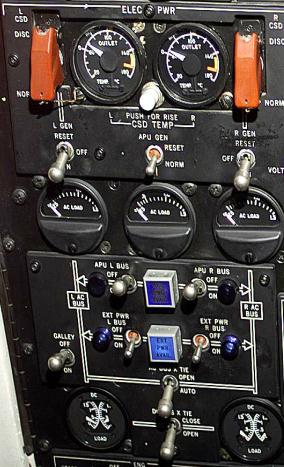
They Keep Going and Going...
When boarding a plane and reviewing the maintenance logs, I often note how nothing has broken on that plane for days or weeks. And when it does it is usually something like a loose arm-rest or a tray table in need of an adjustment. Jet airliners are well maintained.
The FAA mandates that every airline comply with a very strict and comprehensive maintenance schedule.
With all of this maintenance and inspecting there is still more inspecting.
Before the first flight of the day, one of the pilots will do a thorough preflight inspection inside and out. And before flying each leg, the plane receives another walk around inspection by a pilot. On top of that, every day when an aircraft flies through an airline's maintenance base, a mechanic will meet the flight to do a quick checkup on the plane and examine its maintenance logs.
Most maintenance is performed at night during a plane's down time. When there is major maintenance or a scheduled inspection to be done, the plane is taken out of service.
As you can see, these planes are well attended to. Failure of a system or component is rare, and when they do fail, there are backup systems.
As an example, the plane I fly, a DC9 Super 80, has three separate electrical sources including an auxiliary power unit. The plane needs only one electrical source to power all systems. Even if all three sources failed, the airplane's batteries would power the essential systems long enough to land safely. And you know what? Without any electricity, the plane still has a window, wings and engines. It will still fly. It would be back to the basics, but something we could manage.
Later, see details about other aircraft systems (Fuel, Hydraulic, Pressurization, Fire Protection) on the Bonus Web Page.
The Basics of Flight

What makes a plane fly? Wings and speed through the air is all that is required to make a plane fly. The plane is just moving through the air - a fluid. The movement of a plane through the air is like swimming or surfing.
Like water, air is a fluid. Air is just thinner than water, but is still a significant mass. In fact, at this moment, you are experiencing about 15 psi (pounds per square inch) of pressure from our atmosphere. You don't notice it because it has always been there and presses on your body equally from all angles.
Speaking of how strong air can be; have you ever considered what holds your car up? It's not really the tires, it's air pressure - about 32 psi. That's a lot of weight for just some air to support! Think about it.
You may have a hard time believing that something as big as a jet can stay up in the air. What is holding it up there?
Have you ever stuck your hand out a car window at 30 mph, then again at 60 mph? Now multiply the force your hand feels at 60 mph times ten (Actually, the force increases with the square of velocity so it would be even greater, but I don't want to get too technical here.). That is the force your hand would feel flying at the speed of a jetliner! And if your hand was efficiently shaped like a wing, you could almost fly with just your two hands!
The faster you go, the thicker the air feels. To the plane it feels like a thick watery fluid capable of substantial support.
Flying Whales?
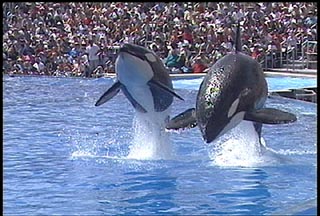
Whales are huge creatures. How can Shamu the Killer Whale fly through the air?
To do this the whale swims to gain speed through the water. Using his tail fin he angles upward and his flippers create the necessary lift to fly up out of the water.
You take big wings and get them going fast and it creates a tremendous lifting force. Big or small, all aircraft fly using the same principles. No magic, just physics.
Wing Flaps
The wing flaps are lowered during takeoff and landing. Wing flaps are used to create more lift so that planes can takeoff and land at slower speeds. The slower speed means the plane will require less runway length.

The wing has a curvature shape which creates lift. The greater the curvature the greater the lift, but with the greater curvature comes greater drag. During high speed cruise it is preferable to have a flat wing to reduce drag.
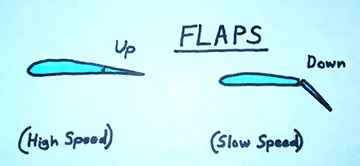
To satisfy both high and slow speed requirements for flight wing flaps are used. After landing the panels which pop up on top of the wing are called speed brakes.
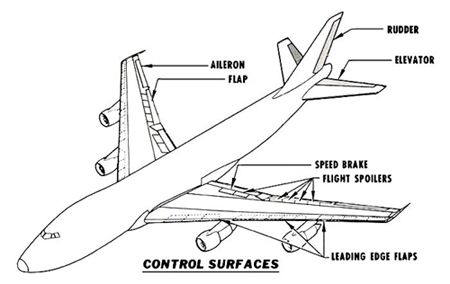
Engines Create Thrust
Some people assume that a plane's engines are responsible for holding a plane up. The engines don't make lift, the engines simply provide the push to keep the plane moving forward so that the wings will create lift. Without the engine's "push", a plane will continue to fly by gliding slowly downward.
I'll let you in on a little secret, jetliners glide on every flight. Normally, about 100 miles from the destination airport, the pilots will throttle back to idle. The engines no longer provide the "push" they are nice and quiet, and this saves fuel. Near the runway the pilots will increase the throttles for any required maneuvering or speed changes.
So when you wonder what is holding the plane in the air, imagine that the air has turned into a thick fluid and the plane is simply swimming through it.
How Does an Airplane Turn?
When flying level, the plane's lift is directed straight up. To turn, we bank (tilt) the plane by moving the wing's control flaps (ailerons). This redirects some of the wing's lift in the direction we wish to turn. Because of the centrifugal force of the turn, we don't feel any sensation of tilting. It is like a bicycle which leans into the direction of the turn.

The plane's built-in stability requires us to actually hold the plane in the bank to turn. You may worry that the plane will tip over in a turn, this cannot happen unless the pilot decides it's time for an air show and rolls the airplane over manually. Not a likely scenario!!!
To move (yaw) the plane side to side we use the rudder.

How Does an Airplane Climb or Descend?
To climb or descend we move the plane's tail "fins" (elevators) which cause the plane to nose up or down. To maintain the desired speed we either increase or decrease the throttle.

There is really no mystery about flying, we have wings to provide lift, engines to push us, and control fins to guide us. Look up at the sky, notice how the planes and birds fly. Think about how they fly. See how they swim through the air. Try to get more comfortable with the idea of flight.
CLICK HERE TO CONTINUE TO LESSON 3 - Part 2